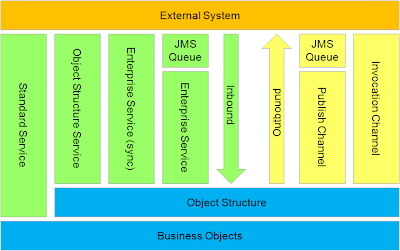This entry is part of the Maximo Integration Framework series.
What is Maximo Integration Framework?
The Maximo Integration Framework (MIF) is an integral part of the Tivoli Process Automation Engine (TPAE) that allows the synchronization and integration of data and of applications between TPAE and external systems in real time or batch mode by using a variety of communication protocols.
Main Concepts
The three main concepts of MIF are:
- Object Structures are collection of Business Objects and relationships that define the content of messages for Channels and Services.
- Services receive data into the system
- Channels send data out of the system
This picture gives an overview of the MIF architecture and of the available services (depicted in green) and channels (depicted in yellow).
Services
The simplest service is the Object Structure Service. It is synchronous and allows to create, update, delete and query data in TPAE's database.
Enterprise Services are more powerful allowing to
process data (synchronous or asynchronous using JMS queues) and have data processing layers that can transform data.
Enterprise Services can use multiple protocols such as Web Services, HTTP, database tables, XML and flat files.
The enterprise service can use the following processing layers:
- Processing Rules – The integration framework provides a rule engine where you can filter and transform the XML message.
- XSL Map – Represents an XSLT style sheet that you can use to transform data and perform mapping of the XML message to another format.
- User Exit and Processing Classes – Represents Java classes that you can use to filter, transform
data, and implement business logic.
Channels
There are two main types of outbound services (channels).
- The Publish Channel is asynchronous and can be triggered by a completed transaction on a primary object with an enabled event listener or by a data export.
- The Invocation Channel is synchronous and can be triggered by an action class called by a user interface control (within an application), a workflow or an escalation.
Both services provides processing rules, XSL map and user/processing classes to transform data.
For more details about MIF go to the Integration Framework page where you can find guides, tutorials and articles.
Another great overview of the Maximo Integration Framework is this IBM White Paper.
Labels: beginner, integration, mif
